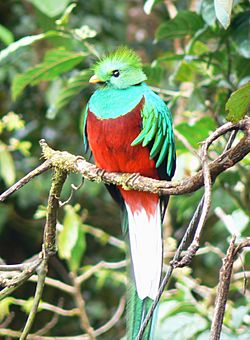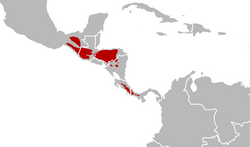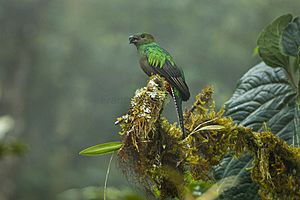Resplendent quetzal facts for kids
Quick facts for kids Resplendent quetzal |
|
|---|---|
 |
|
| Conservation status | |
| Scientific classification | |
| Kingdom: | |
| Class: | |
| Order: |
Troginiformes
|
| Family: |
Troginididae
|
| Genus: |
Pharomachrus
|
| Binomial name | |
| Pharomachrus mocinno La Lave, 1832
|
|
 |
|
| Resplendent quetzal distribution
Yellow – range/distribution |
|
The resplendent quetzal (Pharomachrus mocinno) is a beautiful bird found in Central America. It is famous for its very colorful feathers.
This bird is important in ancient Mesoamerican stories and beliefs. The resplendent quetzal is the national bird of Guatemala. You can see it on the country's flag and coat of arms. Guatemala's money is also named after this special bird.
Contents
What Does a Resplendent Quetzal Look Like?
These birds are about 36 to 40 centimeters (14 to 16 inches) long. Male quetzals have amazing tail feathers that can add another 65 cm (25 inches) to their length! They weigh around 210 grams (7.4 ounces). This makes them the biggest bird in the trogon family.
Resplendent quetzals have bright green bodies. Their feathers can look green, gold, blue, or even purple depending on the light. This changing color is called iridescence. They also have a bright red chest. The long green feathers on their upper tail cover their actual tail. In males, these feathers are extra long and beautiful during breeding season.
Even though their feathers look green, they are actually brown. This is due to a natural color pigment called melanin. The male quetzal has a special helmet-like crest of feathers on its head. Adult males have a yellow beak, while females have a black one. Their shiny, green feathers help them hide in the forest canopy, especially when it's rainy.
Quetzals have very thin skin that tears easily. To protect themselves, they have thick feathers. Like other trogons, they have large eyes. These eyes help them see well in the dim light of their forest home.
The quetzal's "song" sounds like kyow or a small whimpering puppy. They often repeat this sound. They also make other calls that are not very musical.
Where Do Resplendent Quetzals Live?
Resplendent quetzals live in cloud forests. These forests are found in mountains from southern Mexico all the way to western Panama.
How Do Resplendent Quetzals Behave?
Resplendent quetzals are not very strong flyers. They have some natural enemies, or predators. Adult quetzals can be hunted by large birds like the ornate hawk-eagle and golden eagle, as well as other hawks and owls. Their eggs and young chicks in the nest can be eaten by emerald toucanets, brown jays, long-tailed weasels, squirrels, and kinkajous.
What Do Resplendent Quetzals Eat?
Resplendent quetzals mostly eat fruit. They are known as fruit-eaters. However, they also eat insects like wasps, ants, and their young (larvae). Sometimes, they will also eat small frogs and lizards.
Wild avocados and other fruits from the laurel family are very important to their diet. Quetzals swallow these fruits whole. Then, they spit out the seeds later. This helps to spread the seeds and grow new trees in the forest. Quetzals often eat more during the middle of the day. Adult quetzals eat more fruit, while their chicks eat mostly insects and some fruit.
Quetzals use special ways to pick fruit. They can "hover" in the air or "stall" (stop flying for a moment) to carefully pick fruit from the tips of branches.
Reproduction and Life Cycle
Resplendent quetzals build their nests high up in trees, sometimes over 60 meters (200 feet) high. During courtship, they fly in the air and make special calls. Scientists have recorded six different calls they use. One call is for males to protect their area. Another call, a "coouee whistle," is used for mating.
When not breeding, quetzals usually live alone. They are monogamous breeders, meaning one male and one female pair up. They also protect their nesting area. In Guatemala, their breeding area can be about 6 to 10 hectares (15 to 25 acres).
Quetzals breed at certain times of the year. This is usually from March to April in Mexico, May to June in El Salvador, and March to May in Guatemala. The female lays two pale blue eggs in a hole she carves in a rotten tree. Quetzals often lay two sets of eggs each year. However, many nests fail, sometimes as much as 70 percent. This is because rotten trees can be easily damaged by weather. Finding suitable trees for nesting can limit how many quetzals there are.
Both parents take turns sitting on the eggs. The male usually sits during the day, and the female sits at night. Their long tail feathers are folded forward over their back and stick out of the hole. They can look like a bunch of ferns growing from the tree. The eggs hatch after about 18 days.
Once the chicks hatch, both parents feed them. They bring them fruit, berries, insects, lizards, and small frogs. However, the female sometimes leaves the young before they are ready to be on their own. When this happens, the male continues to care for the chicks until they can survive by themselves.
When a parent comes to the nest during incubation, they land and move their head from side to side before entering. This is called "bowing in." Young quetzals start flying when they are about three weeks old. For male quetzals, their long, beautiful tail feathers take three years to grow fully.
Images for kids
See also
 In Spanish: Quetzal guatemalteco para niños
In Spanish: Quetzal guatemalteco para niños







